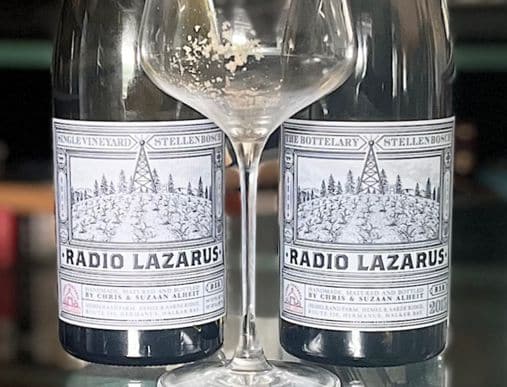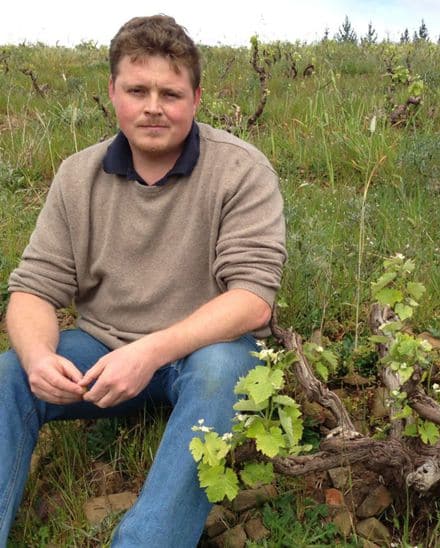Tim James: Radio Lazarus – the taste when the vineyard has gone
By Tim James, 30 June 2025

4

I’d thought I should give the great and famous and expensive wines a rest from this column, but then I had a bottle of Alheit Radio Lazarus 2014 and changed my mind. Though Radio Lazarus is not even a wine that’s been made since the last tiny bottling in 2018, which makes it one that’s of immediate relevance to only a few people. But I hope its story remains of some interest to more: the wine is emblematic in many ways of the South African wine revolution of this century, as well as being – so briefly! – one of the greatest examples of modern Cape chenin.
It’s actually rare for me these days to drink a whole bottle of wine by myself in a sitting, but the level of that 2014 went resolutely down – till the last glassful, which contained the tartrates that you can see sticking to the side of the glass in the photo below. At that point I fired off a message to Chris Alheit (turns out he was with his family on snowy Alpine slopes), telling him that the wine was “as fresh, profound and lovely as I or anyone could have wished. A privilege and joy to drink…. Glad the cork was good!”
I sent that message and included that addendum because, just a few weeks earlier, I’d discussed older vintages with Chris at the tasting of his latest (2024) releases, and he’d been rather doleful about cork problems in the vintages up 2018, when he switched from pressed corks to Diam agglomerates. I myself have had a few problems of premature oxidation with bottles of that period.
This bottle, though, was singing. I’ve previously had bottles of the 2012 Radio Lazarus at ten years that also showed remarkable youthfulness of flavour and freshness, while having the harmony, suavity, deep complexity, and texture of maturity. A great advertisement for the longevity and development potential of fine local chenin. I still have another bottle of this and feel no pressure to open it.
The 2012 was the maiden vintage, and the one that preceded the 2014, as all the 2013 grapes went towards the blend for that year’s Cartology. Which means, in fact, that there were only two released vintages of Radio Lazarus that came from a single vineyard on the Bottelary Hills. From 2015, there was a contribution from a second, nearby, high-lying chenin vineyard (a little higher, a little older, on a hill bristling with even more of the radio masts that gave the wine half of its name).

You can see in the photograph the tweaks made to the labels as a consequence. That of 2014 (on the left) declares it as coming from a “single vineyard”, text replaced for the 2015 by “The Bottelary”. On the bottom right-hand corner, the vineyard co-ordinates of the original version are replaced by the vintage – which had previously appeared only on the “back” label. And on that back label, the new version replaced a reference to “single vineyard wine” with “100% dry farmed hilltop chenin blanc” (the variety hadn’t been mentioned before). And note that the 2015 has a metallic capsule instead of wax.
Forgive all that detail, which perhaps doesn’t fascinate others as much as it does me. Less geekily here’s the evocative little poem that appears on both back labels:
white knuckles old bones twisted arms broken stones
stooping back cracking hands failing light falling night
hidden ruin rescue reckless restless
high land abandon patient prizefighter
The poem clearly alludes to the factors that also gave this wine the second part of its name: Lazarus, the man miraculously restored to life by Jesus Christ according to the Bible. That original vineyard, planted in 1978, had been overworked in its youth, neglected later, and briefly abandoned before the Alheits started resuscitation work on it in 2010

I visited it (and the other vineyard) with Chris in 2015, and noted in a piece I wrote about it on the now-disappeared Grape website how sobering and exhilarating it was seeing him among the vines he’d so tenderly and laboriously worked with for half a decade. I wrote that “Many of the gnarled, heavy stems on the vines of the Radio Lazarus vineyard will never flourish with leaves and grapes again. Too many are dead or implacably dying.” Chris was clearly affected by seeing anew the inevitable doom. You can see that in the photo I took that October day ten years ago (I captioned it “Chris and friend”); he looks disconsolate, as he leans slightly towards the comparatively thriving vine he’s sitting next to.
The years of drought were, in fact, about to begin, and they rapidly destroyed any hope of saving these vines. I reported in 2018, in a piece on this website about the effects of winelands drought, how, in the older of the two Lazarus vineyards, “It wasn’t just the cruel dryness and heat that finished it off; hungry buck, confronted by barren veld, had come like never before to eat what green shoots there were.” Eight final crates of grapes were picked that year off the other, original vineyard, but no wine was commercially released. In their release notes that year, the Alheits wrote of the glimmering of pleasure in knowing that “both vineyards were on death row, due to be ripped up, and yet they lived on a few more years to make some of the loveliest wines we’ve ever had the chance to work with.”
And, yes indeed, some of the loveliest chenin I’ve drunk. If you ever get to have, or share in, a bottle where the cork has cooperated, and enjoy the beauty of Alheit Radio Lazarus (God forbid you should drink it blind and score it), think of those dead, abandoned vines on their Stellenbosch hilltops; that poignancy now must be a part of the taste.
- Tim James is one of South Africa’s leading wine commentators, contributing to various local and international wine publications. His book Wines of South Africa – Tradition and Revolution appeared in 2013.







Gareth | 30 June 2025
Lovely read Tim, and sadly a piece of liquid history that I doubt I’ll every get the chance to sample.
I do wonder if there are any other celebrated labels that might suffer the same fate?
Jamie Johnson | 30 June 2025
I was fortunate to sample the maiden vintage 2012 at the Magnetic North vertical last November and it was showing well.
Johan Raubenheimer | 1 July 2025
Lovely tribute, Tim.
Indeed, an exceptional wine, lovingly crafted by masters of their craft.
I regard myself as privileged to have enjoyed this masterpiece.
Kwispedoor | 2 July 2025
What a truly enjoyable read! A few years ago, the last bottle of 2014 that I have tasted was affected by premox, but despite that, it was still my wine of the day (tasted blind – sorry, Tim 😜). I have two bottles at the moment and it makes the decision to open or not very problematic. If they’re both affected by premox, they’re likely already past their best. If they’re pristine, I’d like to wait. What if only one has premox – will l pick the right one next? 🙈